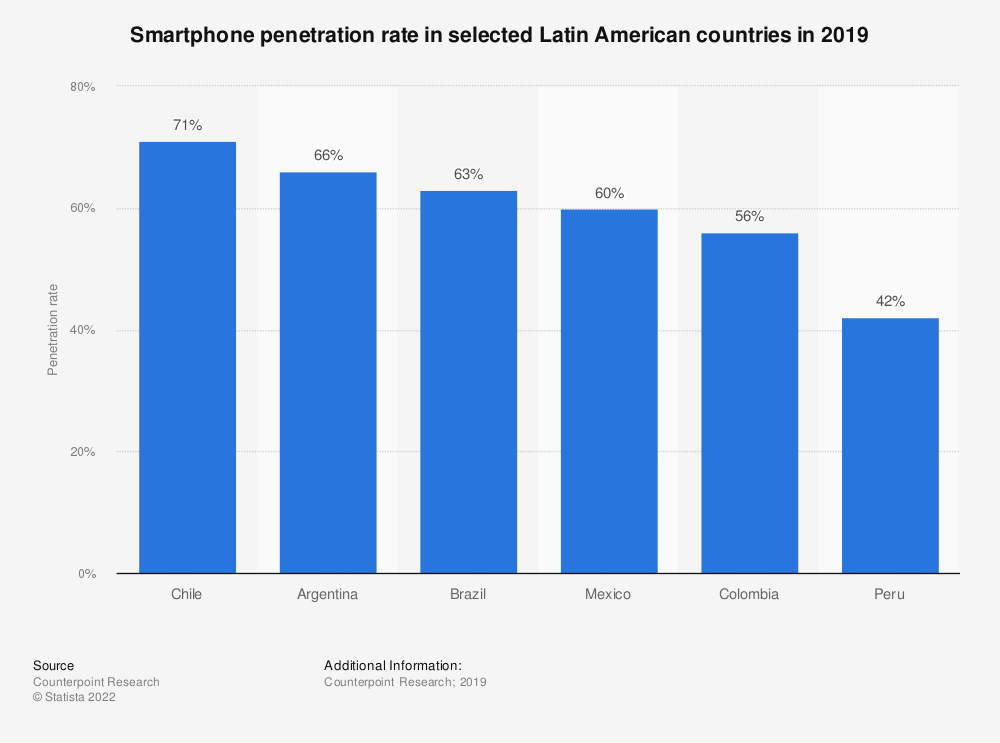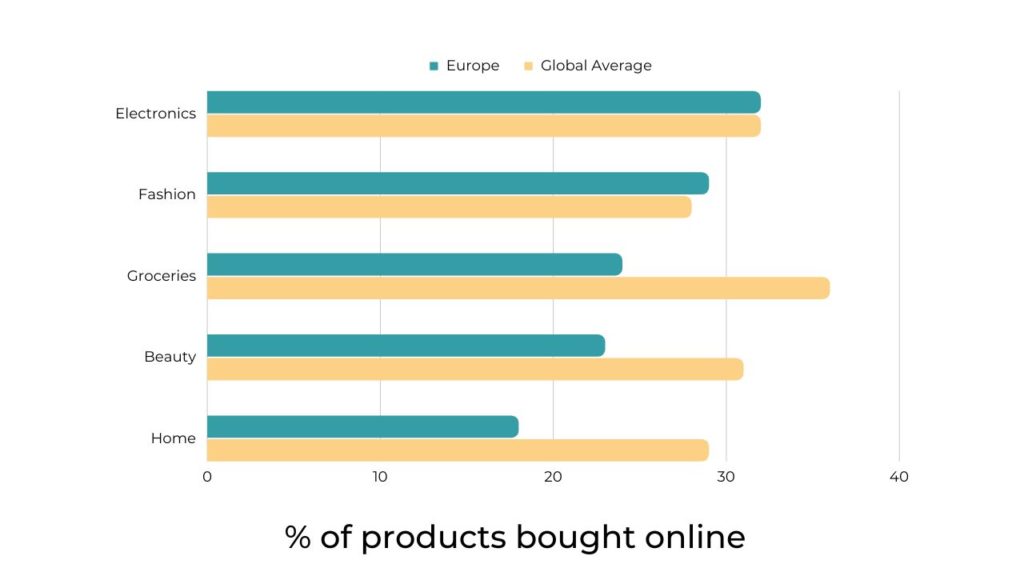
Macro Consumer Trends
When it comes to e-commerce, understanding your audience is key. Different regions and countries have unique consumer behaviors, preferences, and priorities. We’ll take a closer look at some of the most popular macro e-commerce markets and the burgeoning trends coming out of Latin America, Europe, Asia, and Africa.
E-Commerce Trends in Latin America 🌎
Latin America is a diverse region with unique consumer trends and behaviors. The Latin American consumer market is conscious of price and values highly personalized e-commerce experiences. Cash has been dethroned in which credit and in-app purchases are the most popular way to purchase online.
Here are some insights into popular e-commerce markets in Latin America:
Argentina:
Argentine consumers are active online shoppers who prioritize convenience and value. They’re price-sensitive and tend to favor products related to health and wellness, technology, and fashion.
The Argentine consumer market is characterized by price sensitivity and a strong emphasis on value. Consumers are particularly concerned with getting the best deal for their money and are known to be savvy shoppers who compare prices and seek discounts and promotions. This has led to the popularity of online shopping, which allows consumers to easily compare prices and find the best deals.
Chile:
Chilean consumers are tech-savvy and digitally connected, with a high percentage of the population owning smartphones. Social media – Instagram and TikTok – are key channels for marketing products, especially among Gen Z and millennials. Chileans also value sustainability, so eco-friendly and socially responsible products are in high demand.

Mexico:
Mexicans are loyal to local brands and products, and trust plays a big role in purchase decisions. Discounts and promotions are effective marketing strategies; consumers prioritize quality and reliability. Mexican consumers are also interested in innovative products and services, particularly in the tech and entertainment industries.
Brazil:
Brazil has the largest economy in Latin America and a diverse consumer market. Brazilians value personalized attention and customer service, and social connections and relationships often take priority over price. Beauty, health, and food products are popular in Brazil, as well as luxury goods and experiences.
💡 Overall, trust, value, smartphone usage, social media, and innovation are key considerations when selling products in Latin America. It’s important to understand the preferences and priorities of each country’s unique consumer market.
Selling in Latin America? Take note of how you personalize your campaigns for your market.
Use ShoppingFeeder’s Dynamic Discounts to optimize discounts for individual shoppers. Only available for Shopify.
Contact us here to find out how to get set up or visit Manage Services > Dynamic Discounts in the ShoppingFeeder App.
How do Europeans Shop? 🌏
Europe is a vast and diverse market with a range of consumer behaviors and preferences. Here’s what you need to know about e-commerce markets in the UK, Germany, Poland, and Spain:
United Kingdom:
The UK is a mature e-commerce market, with a high percentage of the population shopping online. Mobile shopping is popular, with over half of online purchases made on mobile devices. UK consumers are also interested in personalized experiences and fast delivery. It’s important to know that the Silver Economy (those over the age of 55) are avid online shoppers.
In the UK, online shopping is well-established and the market is highly competitive. British consumers prioritize convenience and value, and are generally open to trying new products and services. E-commerce giants like Amazon dominate the UK market, but there are also opportunities for niche and specialty sales channels.
United Kingdom consumers respond well to advertising campaigns and use Social Media to get their goods. Consider using a combination of Pinterest, Facebook, and Instagram to locate your niche market.
Germany:
Germany has the largest e-commerce market in Europe, and German consumers tend to be cautious shoppers who prioritize quality and reliability. Trust is key, and local payment methods are preferred. German consumers also value eco-friendly and socially responsible products.
German consumers are known for their high standards and value for quality products. They also prioritize data privacy and security when making online purchases. German consumers are less likely to make impulse purchases and often conduct extensive research before making a purchase decision.
Selling in Germany? Remember, reliability and quality are key. If your market relies on Search Engine research, consider Google Shopping and Microsoft Shopping to boost your consumer trust and ensure that your products land at the very top of the search. All you need to do select your channels on the ShoppingFeeder app and get selling!
Poland:
77% of Poles purchase online as a result of Covid-19. Poland is a rapidly growing e-commerce market with a young and tech-savvy population. Polish consumers are interested in innovative products and services and are willing to pay more for high-quality items. They also value fast and reliable delivery.
The e-commerce market in Poland is rapidly growing, with consumers increasingly turning to online channels for purchases. Facebook is the most predominantly used marketplace, followed by Instagram. Polish consumers value affordability and convenience, and are often price-sensitive when making purchase decisions. Social media is also a key channel for marketing products in Poland.
Spain:
Spain has a large e-commerce market, and Spanish consumers tend to be deal-seekers who prioritize price and value. Social media is an effective channel for marketing products, and Spanish consumers also value personalized experiences.
Spanish consumers are highly social and value relationships and connections when making purchase decisions. They also prioritize convenience and affordability, and are open to trying new products and services. E-commerce is growing in Spain, but brick-and-mortar stores are still popular among consumers.

💡 Overall, when marketing to the European consumer market, it’s important to understand the unique trends and behaviors of each country and tailor your messaging and strategies accordingly. Quality, convenience, and affordability are key considerations, as well as data privacy and security. Social media and e-commerce platforms are also important channels for marketing products in these markets.
Consumers in Asia 🌏
Asia is a vast and diverse region with a range of consumer behaviors and preferences. Here’s what you need to know about e-commerce markets in India, Thailand, Vietnam, and the Philippines:
India:
India has a rapidly growing e-commerce market, with a young and tech-savvy population. Indian consumers are interested in innovative products and services and tend to be deal-seekers who prioritize price and value. Cash-on-delivery is a popular payment method in India.
The Indian e-commerce market has experienced remarkable growth in recent years, fuelled by the increasing penetration of smartphones and internet connectivity, higher disposable incomes, and the growing presence of online marketplaces. By 2026, the Indian e-commerce market is expected to be valued at $200 billion, as per a report by the Internet and Mobile Association of India (IAMAI) and Nielsen.
Smartphone and internet adoption are the primary drivers of India’s e-commerce market growth. India is the world’s second-largest internet market, with over 750 million internet users in 2021. The affordability of smartphones has made it easier for more Indians to shop online, leading to increased e-commerce activity. The rise in disposable incomes is another crucial factor behind the e-commerce boom, with online marketplaces providing budget-conscious consumers with more affordable shopping options and convenient access to deals and offers.
Thailand:
Thailand has a rapidly growing e-commerce market, and Thai consumers tend to be deal-seekers who prioritize price and value. They also value convenience and fast delivery, and mobile shopping is popular.
Thailand’s e-commerce market is expected to reach $33 billion by 2025, with an annual growth rate of 22%, making it one of the fastest-growing e-commerce markets in the world. The increasing popularity of online shopping has been fuelled by several factors, including the government’s push towards a cashless society, the rise of social media platforms, and the increasing availability of affordable smartphones.
One unique aspect of the Thai e-commerce market is the popularity of social commerce. Social media platforms, such as Facebook and Instagram, are widely used as a platform for online shopping, with many businesses using social media to market their products and engage with customers.
Vietnam:
Vietnam has a young and tech-savvy population, and Vietnamese consumers are interested in innovative products and services. They tend to be deal-seekers who prioritize price.
In Vietnam, the e-commerce market is rapidly growing, with a high percentage of the population making online purchases. Vietnamese consumers prioritize quality and reliability and often rely on recommendations from family and friends when making purchase decisions. Social media is also an important channel for marketing products in Vietnam, with Facebook, Instagram, and TikTok being predominant sales channels.
Philippines:
The Philippines is a highly mobile-first market, with a large percentage of the population owning smartphones and using them for online purchases. 18-30-year-olds are extensive online shoppers, that spend 10 hours on the internet per day on average.
Filipino consumers value personalized attention and customer service and often prioritize affordability and convenience over brand loyalty. Online marketplaces are popular in the Philippines, so make sure to consider partnering with local e-commerce platforms when selling products in this market.

💡 Quality, affordability, convenience, and mobile friendliness are key considerations for Asian consumers, as well as personalized attention and customer service. Social media and mobile-first channels are also important for marketing products in these markets.
Africa’s E-Commerce Habits 🌍
The e-commerce landscape in Africa is growing rapidly across the continent. Since Africa is such a large continent, it’s important to understand the unique consumer behaviors and preferences in each region, such as price sensitivity, convenience, and trust.
North Africa:
In North Africa, e-commerce is still in the early stages of development, but it is growing rapidly. Egypt, Morocco, and Tunisia are among the countries leading the way. North African consumers tend to be price-sensitive and prioritize convenience and trust. Cash-on-delivery is a popular payment method in this region, as many consumers still do not have access to credit cards. Mobile shopping is also popular, as many North Africans access the internet primarily through their smartphones.
Egypt has a rapidly growing e-commerce market, with consumers increasingly turning to online channels for purchases. Egyptian consumers value convenience and affordability and often use social media for product research and reviews. Egyptians don’t like delays in payments, and 28% will switch retailers if payment methods are insecure.
West Africa:
West Africa is home to some of the fastest-growing e-commerce markets in Africa, including Nigeria and Ghana. Consumers in this region prioritize affordability and convenience, and are often deal-seekers. Online marketplaces are popular in West Africa, and social media is a key channel for marketing products. Mobile shopping is also popular, as many West Africans access the internet primarily through their smartphones.
Cash is king in Nigeria, with 92% opting to purchase with cash. Payment convenience is a must when it comes to Nigerian buyers.
East Africa:
East Africa is home to some of the most innovative e-commerce markets in Africa, including Kenya and Rwanda.
Consumers in this region prioritize affordability and convenience, and are often deal-seekers. Mobile shopping is popular, as many East Africans access the internet primarily through their smartphones. Cash-on-delivery is also a popular payment method, particularly in rural areas where access to credit cards is limited.
In Kenya, mobile payments are also widely used for e-commerce transactions. Who has the highest purchasing power in Kenya? 41% of the Kenyan consumer cohort is over the age of 55! Keep this in mind when you create your campaigns.
Central Africa:
Central Africa is still in the early stages of e-commerce development, but countries like Cameroon and the Democratic Republic of Congo are showing promising growth. Consumers in this region prioritize affordability and convenience, and often rely on social networks for product recommendations. Cash-on-delivery is a popular payment method, as many consumers do not have access to credit cards. Mobile shopping is also popular, particularly among younger consumers.
Southern Africa:
Southern Africa has a mature e-commerce market, with South Africa being the largest market in the region. Consumers in this region prioritize convenience and trust, and are often deal-seekers. Online marketplaces are popular, and social media is a key channel for marketing products. Mobile shopping is also popular, as many Southern Africans access the internet primarily through their smartphones. Credit cards are the most popular payment method in this region, but cash-on-delivery is also used.
South Africans rely heavily on their phones to make purchases. They’re more likely to make app-based purchases or use search engines to find products. South Africans love to purchase electronics, then home and garden goods. Did someone say #solarenergy?
💡 Overall, e-commerce in Africa is growing rapidly, with consumers across the continent increasingly turning to online channels for purchases. Understanding the unique consumer behaviors and preferences in each region is key to success in these markets.
🌎 Thinking of penetrating one of these markets? We’d recommend a multi-channel strategy for your campaigns using Facebook, Instagram, TikTok, and Pinterest. Register with ShoppingFeeder and we’ll get you set up.
Conclusion
Understanding consumer behavior, preferences, and priorities is crucial when it comes to e-commerce. Latin America, Europe, Asia, and Africa are diverse regions with unique consumer trends and behaviors that e-commerce businesses should take into account. For example, in Latin America, consumers are price-sensitive and value personalized experiences, while in Europe, consumers prioritize quality, reliability, and personalized experiences. Additionally, social media is a key marketing channel for many regions, including Chile and Poland. Ultimately, e-commerce businesses that understand the unique preferences of their target audience can develop effective marketing strategies and increase their chances of success, be it cross-border or local.
Want to find out more? Contact ShoppingFeeder.




